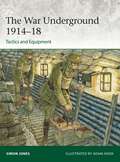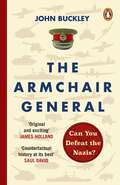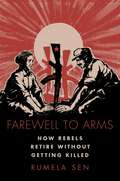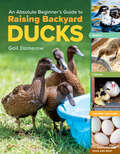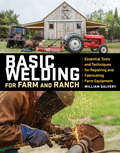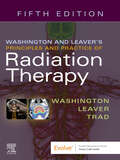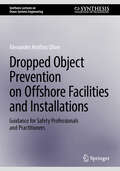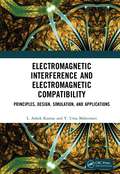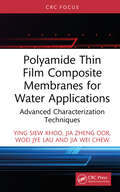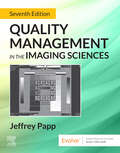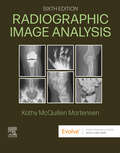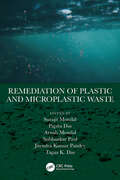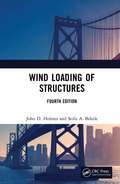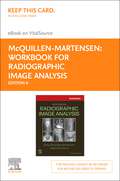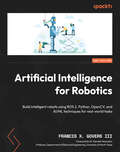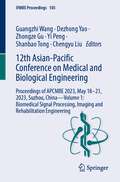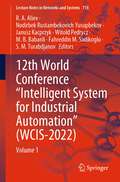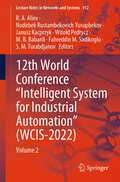- Table View
- List View
The War Underground 1914–18: Tactics and Equipment (Elite #256)
by Simon JonesThis absorbing illustrated study reveals the evolving tactics and techniques used by all sides in the underground war during 1914–18. Covering the Western Front but also the Gallipoli and Italian theatres, this study explores three aspects of World War I below ground: military mining, attack tunnels and dugouts. In 1914–17, the underground war was a product of static trench warfare, essential to survive it and part of both sides' attempts to overcome it. In 1917–18 it was rendered largely obsolete by the development of the all-arms battle as mobility was restored to the battlefield. In the stagnant, troglodyte existence of trench warfare, military mining was a hidden world of heroism and terror in which hours of suspenseful listening were spent monitoring the steady picking of unseen opponents, edging quietly towards the enemy, and judging when to fire a charge. Break-ins to enemy mine galleries resulted in hand-to-hand fighting in the darkness. The ingenuity, claustrophobia and tactical importance of the underground war are discussed and depicted in this fully illustrated study from an acknowledged expert. The artwork plates include depictions of the specialized uniforms, weapons and equipment used underground, as well as vignettes that vividly convey the many aspects of subterranean warfare during World War I.
The Armchair General: Can You Defeat the Nazis? (The Armchair General #1)
by John Buckley***AVAILABLE FOR PRE-ORDER NOW***A ground-breaking approach to history where YOU choose the fate of WWII - perfect for readers of Bletchley Park Brainteasers and The GCHQ Puzzle Book.____________________________________________________________________________TAKE THE HOTSEATAssume the role of real Generals, Leaders, Soldiers and Intelligence Officers in the Allied Forces during WWII, including Winston Churchill and President Eisenhower.EXAMINE THE INTELLIGENCEExplore eight key moments of the war with real contemporaneous intelligence: Britain's Darkest Hour, 1940; The War in North Africa; Stalin's War on the Eastern Front; The Pacific Battle of Midway; The Dresden Bomber Offensive; Casablanca; Arnhem and Operation Market Garden; The Bomb and Hiroshima.CONSIDER THE SCENARIO & MAKE YOUR DECISIONFrom battlefields to war cabinets, each tactical and strategic decision you make leads to a different outcome.Will you follow the path of the past - or shape a new history?________________________'An original and exciting approach . . . Buckley is one of our very finest historians. The Armchair General adds enormously to our understanding of the conflicts.' JAMES HOLLAND'A reminder that history is a never ending now, a relentless and endless present that comes without the luxury of hindsight.' AL MURRAY, comedian and writer
Farewell to Arms: How Rebels Retire Without Getting Killed (Modern South Asia)
by Rumela SenHow, in the absence of institutional mechanisms, do Maoist rebels in India quit an ongoing insurgency without getting killed? How do rebels give up arms and return to the same political processes that they had once sought to overthrow? The question of weaning rebels away from extremist groups is highly significant in counterinsurgency and in the pacification of insurgencies. In Farewell to Arms, Rumela Sen goes to the rebels themselves and breaks down the protracted process of rebel retirement into a multi-staged journey as the rebels see it. She draws on several rounds of interviews with current and former Maoist rebels as well as security personnel, administrators, activists, politicians, and civilians in two conflict zones in North and South India. The choice to quit an insurgency, she finds, depends on locally embedded, informal exit networks. The relative weakness of these networks in North India means that fewer rebels quit than in the South, where more feel that they can disarm without getting killed. Sen shows that these networks grow out of the grassroots civic associations in the gray zone of state-insurgency interface. Correcting the course for future policy, Sen provides a new explanation of rebel retirement that will be essential to any policymaker or scholar working to end protracted insurgencies.
An Absolute Beginner's Guide to Raising Backyard Ducks: Breeds, Feeding, Housing and Care, Eggs and Meat
by Gail DamerowThis inspiring introductory guide provides all the information beginners need to raise ducks successfully in the yard or on a small homestead or farm. Ducks are quickly gaining on chickens as popular animals for the backyard homestead or small farm. They are friendly, productive, good at eating pests, remarkably healthy, and easier to raise than chickens in many ways. Plus, they are exceptionally adorable! This accessible introductory guide features original photography tracking the growth and care of a small flock of backyard ducks, and addresses everything the beginner duck keeper needs to know to be successful, including breed selection, housing, feeding, health care, understanding behavior, and egg and meat production. This publication conforms to the EPUB Accessibility specification at WCAG 2.0 Level AA.
Basic Welding for Farm and Ranch: Essential Tools and Techniques for Repairing and Fabricating Farm Equipment
by William GalveryThis guidebook to the essential tools and skills needed for basic welding teaches even the novice everything they need to know to do it themselves, with projects and techniques specially tailored for farm and ranch equipment fabrication and repairs.
Washington & Leaver’s Principles and Practice of Radiation Therapy E-Book: Washington & Leaver’s Principles and Practice of Radiation Therapy E-Book
by Charles M. Washington Dennis T Leaver Megan TradWashington & Leaver’s Principles and Practice of Radiation Therapy E-Book
Computer Vision: Challenges, Trends, and Opportunities (Chapman & Hall/CRC Computer Vision)
Computer vision has made enormous progress in recent years, and its applications are multifaceted and growing quickly, while many challenges still remain. This book brings together a range of leading researchers to examine a wide variety of research directions, challenges, and prospects for computer vision and its applications.This book highlights various core challenges as well as solutions by leading researchers in the field. It covers such important topics as data-driven AI, biometrics, digital forensics, healthcare, robotics, entertainment and XR, autonomous driving, sports analytics, and neuromorphic computing, covering both academic and industry R&D perspectives. Providing a mix of breadth and depth, this book will have an impact across the fields of computer vision, imaging, and AI.Computer Vision: Challenges, Trends, and Opportunities covers timely and important aspects of computer vision and its applications, highlighting the challenges ahead and providing a range of perspectives from top researchers around the world. A substantial compilation of ideas and state-of-the-art solutions, it will be of great benefit to students, researchers, and industry practitioners.
Dropped Object Prevention on Offshore Facilities and Installations: Guidance for Safety Professionals and Practitioners (Synthesis Lectures on Ocean Systems Engineering)
by Alexander Arnfinn OlsenThe prevention of dropped objects is an important component of safeguarding personnel, property and the maritime environment. This concise book has been developed to provide safety professionals and practitioners with specific guidance and criteria on the development, implementation and management of dropped object prevention programs which corresponds to a growing industry-wide development to mitigate and eliminate the hazards imposed by dropped objects. This book relates to the Class requirements for an onboard dropped object prevention program to be implemented on offshore assets, and provides the design requirements for equipment primary securing, secondary retention methods and securing for specific equipment, etc. This book is intended for use by offshore installation Owners, Operators, and Companies whose intention is to prepare for, and ultimately apply for optional Class notations highlighting the installation’s compliance with dropped object safety management. For the benefit of context, the book uses the provisions which relate specifically to the DOPP and DOPP+ notations.
Electromagnetic Interference and Electromagnetic Compatibility: Principles, Design, Simulation, and Applications
by L. Ashok Kumar Y. Uma MaheswariElectromagnetic compatibility is concerned with the generation, transmission, and reception of electromagnetic energy. The book discusses about the basic principles of electromagnetic interference (EMI) and electromagnetic compatibility (EMC) including causes, events, and mitigation of issues. The design procedures for EMI filter, the types of filters, and filter implementation methods are explained. The simulation of printed circuit board designs using different software and a step-by-step method is discussed in detail. This book addresses the gap between theory and practice using case studies with design, experiments, and supporting analysis. Features:• Discusses about the basic principles of EMI/EMC including causes and events.• Makes readers understand the problems in different applications because of EMI/EMC and the reducing methods.• Explores real-world case studies with code to provide hands-on experience.• Reviews design strategies for mitigation of noise.• Includes MATLAB, PSPICE, and ADS simulations for designing EMI Filter circuits. The book is aimed at graduate students and researchers in electromagnetics, circuit and systems, and electrical engineering.
Electromagnetic Interference and Electromagnetic Compatibility: Principles, Design, Simulation, and Applications
by L. Ashok Kumar Y. Uma MaheswariElectromagnetic compatibility is concerned with the generation, transmission, and reception of electromagnetic energy. The book discusses about the basic principles of electromagnetic interference (EMI) and electromagnetic compatibility (EMC) including causes, events, and mitigation of issues. The design procedures for EMI filter, the types of filters, and filter implementation methods are explained. The simulation of printed circuit board designs using different software and a step-by-step method is discussed in detail. This book addresses the gap between theory and practice using case studies with design, experiments, and supporting analysis. Features:• Discusses about the basic principles of EMI/EMC including causes and events.• Makes readers understand the problems in different applications because of EMI/EMC and the reducing methods.• Explores real-world case studies with code to provide hands-on experience.• Reviews design strategies for mitigation of noise.• Includes MATLAB, PSPICE, and ADS simulations for designing EMI Filter circuits. The book is aimed at graduate students and researchers in electromagnetics, circuit and systems, and electrical engineering.
Plant Growth Regulators to Manage Biotic and Abiotic Stress in Agroecosystems
Plant Growth Regulators to Manage Biotic and Abiotic Stress in Agroecosystems is a comprehensive book that explores the use of plant growth regulators (PGRs) as effective stress-reduction techniques in agricultural environments. This book investigates the role of PGRs in handling biotic and abiotic stressors, offering useful insights to agriculturalists, researchers, and students. The book provides a comprehensive overview of many PGRs, including their methods of action and impacts on plant growth and development. It describes the use of PGRs to treat plant diseases caused by pathogens such as fungi, bacteria, and viruses. The book also discusses the application of PGRs to improve plant tolerance to adverse climatic circumstances including drought, salt, and extreme temperatures. The authors also underline PGRs' sustainable and environmentally friendly character, which makes them a potential option for chemical therapies. They explore PGRs' potential to improve agricultural yield and resilience, therefore helping food security in a rapidly changing global environment. This book is an excellent resource for learning about the applications and advantages of PGRs in modern agriculture.
Polyamide Thin Film Composite Membranes for Water Applications: Advanced Characterization Techniques
by Ying Siew Khoo Jia Zheng Oor Woei Jye Lau Jia Wei ChewThe global market for polymeric membranes used in water and wastewater treatment is experiencing robust growth, with polyamide (PA) thin film composite (TFC) membranes dominating reverse osmosis (RO) and nanofiltration (NF) processes. This monograph presents the latest trends in characterization techniques for PA TFC membranes and provides the most current and relevant information on these techniques tailored specifically for TFC NF and RO membranes.Features• Focuses solely on the characterization of PA TFC membranes used in water and wastewater treatment.• Provides the latest insights into employing advanced and emerging characterization tools to analyze the intrinsic properties of the PA selective layer and evaluate the overall performance of PA TFC membranes during filtration processes.• Extensively examines the strengths and limitations of each membrane characterization tool, offering in-depth analyses for readers.This book is an indispensable reference and practical guide for advanced students, researchers, and scientists involved in NF and RO membrane fabrication and characterization, including those in the fields of chemical, materials, and environmental engineering.
Polyamide Thin Film Composite Membranes for Water Applications: Advanced Characterization Techniques
by Ying Siew Khoo Jia Zheng Oor Woei Jye Lau Jia Wei ChewThe global market for polymeric membranes used in water and wastewater treatment is experiencing robust growth, with polyamide (PA) thin film composite (TFC) membranes dominating reverse osmosis (RO) and nanofiltration (NF) processes. This monograph presents the latest trends in characterization techniques for PA TFC membranes and provides the most current and relevant information on these techniques tailored specifically for TFC NF and RO membranes.Features• Focuses solely on the characterization of PA TFC membranes used in water and wastewater treatment.• Provides the latest insights into employing advanced and emerging characterization tools to analyze the intrinsic properties of the PA selective layer and evaluate the overall performance of PA TFC membranes during filtration processes.• Extensively examines the strengths and limitations of each membrane characterization tool, offering in-depth analyses for readers.This book is an indispensable reference and practical guide for advanced students, researchers, and scientists involved in NF and RO membrane fabrication and characterization, including those in the fields of chemical, materials, and environmental engineering.
Quality Management in the Imaging Sciences - E-Book: Quality Management in the Imaging Sciences - E-Book
by Jeffrey PappMaster all aspects of quality management and control in today’s imaging environment! A true one-of-a-kind text, Quality Management in the Imaging Sciences, 7th Edition provides the information you need to ensure that radiographic equipment operates properly and that it functions within accepted standards. Step-by-step instructions provide a guide to evaluating equipment and documenting results. Also included is coverage of the latest federal regulations, advances in technology, and current QM certification requirements. Written by physics and diagnostic imaging educator Jeffrey Papp, this resource is an excellent tool to help you prepare for the ARRT® Quality Management Advanced Level Examination. Coverage of quality management for all imaging sciences includes X-ray equipment, fluoroscopy, CT, MRI, sonography, and mammography. Step-by-step QM procedures include detailed instructions on how to evaluate imaging equipment, and full-sized sample documentation forms offer practice in recording results. Special icon and bolded type identify federal regulations important to quality management. Learning features include chapter outlines, learning objectives, key terms (with definitions in the glossary), lab experiments, and review questions at the end of each chapter. Useful appendix includes a review of the radiographic quality factors and a listing of agencies, organizations, and committees related to quality control and assurance. Two 160-question practice exams on the Evolve website help you prepare for the ARRT advanced certification examination in Quality Management. NEW! Updated content reflects the latest ARRT® Quality Management certification requirements. NEW! Imaging updates include new technologies, current regulations, and ACR® accreditation requirements.
Radiographic Image Analysis - E-Book: Radiographic Image Analysis - E-Book
by Kathy McQuillen-MartensenGain the knowledge and skills you need to analyze radiographic images and solve imaging challenges! Reflecting the latest ARRT® content specifications, Radiographic Image Analysis, 6th Edition provides a guide to evaluating and adjusting images to produce diagnostic-quality radiographs. It helps you to identify the error in positioning or technique that may have caused a poor image, then shows how to correct the problem, so you can reduce the need for repeat radiographs. Each projection includes an optimal radiograph along with examples of unacceptable images. Written by radiology expert Kathy McQuillen Martensen, this text builds your critical thinking skills and helps you prepare for success on the ARRT certification examination. Chapter objectives, key terms, outlines, and summaries reinforce the most important material. Image analysis guidelines for each procedure include accurately positioned projections with labeled anatomy, photographs of accurately positioned models, discussions of poor positioning and of positioning variations, practice projections that demonstrate common procedural errors, and more. Questions to Consider help you thoroughly analyze projections. Spotlights highlighting Concepts boxes emphasize the most important information and direct readers to additional information on these topics. Review questions at the end of chapters help you assess your understanding of the material, with answers provided on the Evolve website. Summary tables provide quick access to important data for easy reference. Bolded key terms are defined in the expanded glossary, ensuring that you understand the terms under discussion. NEW! Additional images help you to evaluate and correct positioning errors, and other images are replaced with more robust digital halftones. NEW! Revamped chapters on digital imaging incorporate the latest technology. NEW! Updates reflect the latest ARRT® content specifications.
Remediation of Plastic and Microplastic Waste
by Surajit Mondal Papita Das Arnab Mondal Subhankar Paul Jitendra Kumar Pandey Tapas K. DasThis book provides recent developments and advancements in management of plastic wastes and associated challenges with it. It primarily addresses the issues of plastics that might drastically affect the lifeform in the long run and its prevention by introducing appropriate alternatives and/or finding strategies to mitigate the existing microplastic crisis using suitable approaches. It focusses on efforts on neutralizing and restricting further spread of microplastic pollution, its bioaccumulation and associated human health impacts. Features: Covers technological mitigation of plastics and microplastic wastes along with their remediation in a technical manner. Discusses advances in plastic and micro-/nano-plastic pollution and possible pathways of pollution. Demonstrates the mitigation measures to minimize such pollution loads, with a special focus on the application of nanotechnology. Reviews recycle and value-added products from the waste plastic. Focusses on development of alternate clean energy sources. This book is aimed at researchers and graduate students in environmental and chemical engineering and remediation.
Remediation of Plastic and Microplastic Waste
by Surajit Mondal Papita Das Arnab Mondal Subhankar Paul Jitendra Kumar Pandey Tapas K. DasThis book provides recent developments and advancements in management of plastic wastes and associated challenges with it. It primarily addresses the issues of plastics that might drastically affect the lifeform in the long run and its prevention by introducing appropriate alternatives and/or finding strategies to mitigate the existing microplastic crisis using suitable approaches. It focusses on efforts on neutralizing and restricting further spread of microplastic pollution, its bioaccumulation and associated human health impacts. Features: Covers technological mitigation of plastics and microplastic wastes along with their remediation in a technical manner. Discusses advances in plastic and micro-/nano-plastic pollution and possible pathways of pollution. Demonstrates the mitigation measures to minimize such pollution loads, with a special focus on the application of nanotechnology. Reviews recycle and value-added products from the waste plastic. Focusses on development of alternate clean energy sources. This book is aimed at researchers and graduate students in environmental and chemical engineering and remediation.
Wind Loading of Structures
by John D. Holmes Seifu BekeleWind forces from extreme wind events are the dominant loading for many parts of the world, exacerbated by climate change and the continued construction of tall buildings and structures. This authoritative source, for practising and academic structural engineers and graduate students, ties the principles of wind loads on structures to the relevant aspects of meteorology, bluff-body aerodynamics, probability and statistics, and structural dynamics. This new edition covers: Climate change effects on extreme winds – particularly those from tropical cyclones, hurricanes, and typhoons Modelling of potential wind vulnerability and damage Developments in extreme value probability analysis of extreme windspeeds and directions Explanation of the difference between ‘return period’ and ‘average recurrence interval’, as well as ‘bootstrapping’ techniques for deriving confidence limits Wind over water, and profiles and turbulence in non-synoptic winds An expanded chapter on internal pressures produced by wind for various opening and permeability scenarios Aerodynamic shaping of high- and low-rise buildings Recent developments in five major wind codes and standards A new chapter on computational fluid dynamics (CFD), as applied to wind engineering A greatly expanded appendix providing basic information on extreme wind climates for over 140 countries and territories. Additional examples for many chapters in the book
Wind Loading of Structures
by John D. Holmes Seifu BekeleWind forces from extreme wind events are the dominant loading for many parts of the world, exacerbated by climate change and the continued construction of tall buildings and structures. This authoritative source, for practising and academic structural engineers and graduate students, ties the principles of wind loads on structures to the relevant aspects of meteorology, bluff-body aerodynamics, probability and statistics, and structural dynamics. This new edition covers: Climate change effects on extreme winds – particularly those from tropical cyclones, hurricanes, and typhoons Modelling of potential wind vulnerability and damage Developments in extreme value probability analysis of extreme windspeeds and directions Explanation of the difference between ‘return period’ and ‘average recurrence interval’, as well as ‘bootstrapping’ techniques for deriving confidence limits Wind over water, and profiles and turbulence in non-synoptic winds An expanded chapter on internal pressures produced by wind for various opening and permeability scenarios Aerodynamic shaping of high- and low-rise buildings Recent developments in five major wind codes and standards A new chapter on computational fluid dynamics (CFD), as applied to wind engineering A greatly expanded appendix providing basic information on extreme wind climates for over 140 countries and territories. Additional examples for many chapters in the book
Workbook for Radiographic Image Analysis - E-Book: Workbook for Radiographic Image Analysis - E-Book
by Kathy McQuillen-Martensen Stephanie HarrisReview, practice, and apply concepts of digital imaging and positioning! With chapters corresponding to the chapters in Radiographic Image Analysis, 6th Edition, this practical workbook provides projections and questions to help you hone your imaging and evaluation skills. Exercises for each procedure ask you to correct positioning errors, practice critical thinking, and solve positioning challenges. Adding evaluation images beyond those in the main text, this workbook helps you prepare for success on the ARRT® certification examination and in radiography practice. Positioning and technique exercises help with knowledge retention and prepare you for success in radiography practice. Study questions for each procedure focus on how the patient should be positioned to obtain an accurately positioned projection, and help you prepare for the ARRT® certification examination. Poorly positioned projections not included in the textbook focus on each topic and procedure, and ask you to find the cause of the problem. Questions on improperly positioned projections ask you to evaluate the image and make adjustments when the images are suboptimal. Answer key to the study questions may be found on the Evolve website for Radiographic Image Analysis, under student resources. NEW! Updated content reflects the changes and new information in the 6th edition of Radiographic Image Analysis.
Artificial Intelligence for Robotics: Build intelligent robots using ROS 2, Python, OpenCV, and AI/ML techniques for real-world tasks
by Francis X. Govers IIILearn how to apply artificial intelligence, engineering, and machine learning to create smart robots capable of interacting with their environment, engaging with users, making decisions, and navigating autonomouslyKey FeaturesGain a holistic understanding of robot design, systems engineering, and task analysisImplement AI/ML techniques to detect and manipulate objects and navigate robots using landmarksIntegrate voice and natural language interactions to create a digital assistant and artificial personality for your robotPurchase of the print or Kindle book includes a free PDF eBookBook DescriptionUnlock the potential of your robots by enhancing their perception with cutting-edge artificial intelligence and machine learning techniques. From neural networks to computer vision, this book equips you with the tools and practical use cases to create truly smart robots. Starting with robotics basics, robot architecture, control systems, and decision-making theory, this book presents systems-engineering methods to design problem-solving robots with single-board computers. You’ll explore object recognition and genetic algorithms to teach your robot to identify and pick up objects, and you'll also harness the power of natural language processing to give your robot a voice. To enhance your robot further, you’ll master neural networks to classify and separate objects and navigate autonomously, before advancing to guiding your robot arms using reinforcement learning and genetic algorithms. The book also covers path planning and goal-oriented programming to prioritize your robot's tasks, showing you how to connect all software using Python and ROS 2 for a seamless experience. By the end of this book, you’ll have learned how to transform your robot into a helpful assistant with NLP and give it an artificial personality, ready to tackle real-world tasks and even crack jokes.What you will learnGet started with robotics and AI essentialsUnderstand path planning, decision trees, and search algorithms to enhance your robotExplore object recognition using neural networks and supervised learning techniquesEmploy genetic algorithms to enable your robot arm to manipulate objectsTeach your robot to listen using Natural Language Processing through an expert systemProgram your robot in how to avoid obstacles and retrieve objects with machine learning and computer visionApply simulation techniques to give your robot an artificial personalityWho this book is forThis book is for practicing robotics engineers and enthusiasts aiming to advance their skills by applying AI and ML techniques. Students and researchers looking for practical guidance for solving specific problems or approaching a difficult robot design will find this book insightful. Proficiency in Python programming, familiarity with electronics and wiring, single board computers, Linux-based command-line interface (CLI), and knowledge of AI/ML concepts are required to get started with this book.
A Tinkerer's Guide to CNC Basics: Master the fundamentals of CNC machining, G-Code, 2D Laser machining and fabrication techniques
by Samer NajiaGet started with CNC machining using this hands-on guide that tells you exactly what you need to know without overloading you with useless theoryKey FeaturesGet started with the basics of CNC machining and set up your own computerized workshopExplore loads of do-it-yourself projects to practice what you’ve learnedTake advantage of the potential of home machining thanks to the power of CNCBook DescriptionUntil recently, Computer Numerical Control (CNC) machines belonged to the realm of heavy industry, but as technology becomes cheaper and smaller, these machines now can be used in home workshops. It’s not easy to get started, though, but thanks to this guide, you’ll be ready to take on a variety of projects in no time. A Tinkerer’s Guide to CNC Basics contains everything you need to get set up at home with computer-controlled machining and fabrication. Sparing you the theory, this project-laden guide helps you learn by doing. Once you’ve got to grips with the principles of CNC and installed the 3018 Pro CNC machine, you’ll gradually move from simple projects such as basic engraving to more complex milling and machining techniques. You’ll even learn how to upgrade your machine to accomplish more sophisticated designs. The plethora of projects in this book will keep you busy and give you the practice you need to get started with your computerized workshop. By the end of the book, your computerized home workshop will be one step closer to realization, and your machining skills will be taken to the next level.What you will learnConfigure, calibrate, provision, and test your CNC machineAdd a laser engraver to your machine for finer precision cuttingUse the machine to fabricate new components for itselfExplore the design impacts of carving on a rotary axisAdapt other machines for CNCEngrave opaque and semi-opaque materialsCool your machine with an air assist systemDesign and develop a customized laser mountWho this book is forThis book is for tinkerers, hobbyists, and craft aficionados comfortable using hand tools, aspiring to accelerate or develop more complex and challenging projects. Before starting this book, you should be comfortable around basic shop tools, as well as have a basic understanding of computers. While the book will speak to the specifics around the electronics of CNC machines, the terms used, such as motherboard, USB, positive/negative terminal, and power supply should not be too daunting to understand.
12th Asian-Pacific Conference on Medical and Biological Engineering: Proceedings of APCMBE 2023, May 18–21, 2023, Suzhou, China—Volume 1: Biomedical Signal Processing, Imaging and Rehabilitation Engineering (IFMBE Proceedings #103)
by Guangzhi Wang Dezhong Yao Zhongze Gu Yi Peng Shanbao Tong Chengyu LiuThis book presents cutting-edge research and developments in the field of medical and biological engineering, which a special emphasis on activities carried out in the Asian-Pacific region. Gathering the proceedings of the 12th Asian-Pacific Conference on Medical and Biological Engineering (APCMBE 2023), held on May 18–21, 2023, in Suzhou, China, this first volume of a two-volume set focuses on biomedical imaging and signal processing, biomedical sensing and wearables, and rehabilitation and neural engineering. All in all, this book offers extensive information on the state-of-the-art solutions and challenges in biomedical and clinical engineering, addressing a broad audience of medical scientists, engineers, physicists and other researchers and professionals.
12th World Conference “Intelligent System for Industrial Automation”: Volume 1 (Lecture Notes in Networks and Systems #718)
by R. A. Aliev Nodirbek Rustambekovich Yusupbekov Janusz Kacprzyk Witold Pedrycz M. B. Babanli Fahreddin M. Sadikoglu S. M. TurabdjanovThis book presents the first volume of the proceedings of the 12th World Conference "Intelligent systems for industrial automation", WCIS-2022 held in Tashkent, Uzbekistan, on November 25-26, 2022. It includes contributions from diverse areas of intelligent industrial systems design, intelligent information systems, decision making under imperfect information and others. The topics of the papers include hybrid control systems, pattern recognition, industry 4.0, information security, neural computing, fuzzy computation, decision making and support systems, and others.
12th World Conference “Intelligent System for Industrial Automation”: Volume 2 (Lecture Notes in Networks and Systems #912)
by R. A. Aliev Nodirbek Rustambekovich Yusupbekov Janusz Kacprzyk Witold Pedrycz M. B. Babanli Fahreddin M. Sadikoglu S. M. TurabdjanovThis book presents the proceedings of the 12th World Conference "Intelligent systems for industrial automation", WCIS-2022 held in Tashkent, Uzbekistan, on November 25-26, 2022. It includes contributions from diverse areas of intelligent industrial systems design, intelligent information systems, decision making under imperfect information and others.The topics of the papers include hybrid control systems, pattern recognition, industry 4.0, information security, neural computing, fuzzy computation, decision making and support systems, and others.
